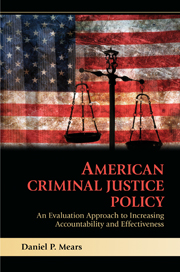 American Criminal Justice Policy
American Criminal Justice Policy Book contents
- Frontmatter
- Contents
- Preface
- 1 Introduction
- 2 Irrational Criminal Justice Policy
- 3 A Solution for Improving Criminal Justice Policy
- 4 Needs Evaluations
- 5 Theory Evaluations
- 6 Implementation Evaluations
- 7 Outcome Evaluations and Impact Evaluations
- 8 Cost-Efficiency Evaluations
- 9 Conclusion
- Notes
- References
- Index
8 - Cost-Efficiency Evaluations
Published online by Cambridge University Press: 05 June 2012
- Frontmatter
- Contents
- Preface
- 1 Introduction
- 2 Irrational Criminal Justice Policy
- 3 A Solution for Improving Criminal Justice Policy
- 4 Needs Evaluations
- 5 Theory Evaluations
- 6 Implementation Evaluations
- 7 Outcome Evaluations and Impact Evaluations
- 8 Cost-Efficiency Evaluations
- 9 Conclusion
- Notes
- References
- Index
Summary
When all is said and done, we not only want criminal justice policies to produce intended outcomes, like less crime; we also want the most “bang for the buck.” That is, we want policies that provide the most benefit for the least cost.
Most of us implicitly apply this logic in our day-to-day decision making. For example, we typically want a mode of transportation, such as a car, that reliably gets us to our destination, but we also want to pay as little as possible for it. Although the decision-making calculus may be complicated, the formula that we apply is not: among the available cars from which we can choose, we want the one that maximizes the benefit (e.g., reliable transportation) and minimizes costs (e.g., purchase price, repairs, fuel) over some set period of time.
The formula applies as well when we have competing goals, but the calculations can be a bit more challenging. Perhaps we have a car that will no longer run. Then we learn that we have a dental problem that, if untreated, will lead to substantial pain. We need the car to get to work, but we also need surgery to live without pain. If we have the funds and no other competing demands, we could pay for both. Problem solved. However, many people face a real dilemma: buy a car or pay for surgery?
- Type
- Chapter
- Information
- American Criminal Justice PolicyAn Evaluation Approach to Increasing Accountability and Effectiveness, pp. 207 - 237Publisher: Cambridge University PressPrint publication year: 2010


